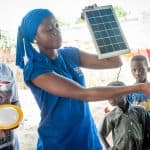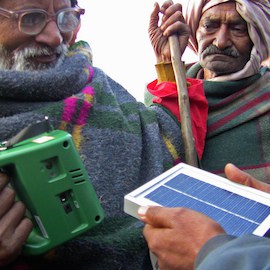An Impact Investor Urges Caution on the ‘Energy Access Hype Cycle’
A typical, commercial fund manager receives investor commitments based on a particular thesis. In a rational yet self-reinforcing cycle, the fund manager becomes a cheerleader for that investment proposition. Even if evidence subsequently mounts that the thesis may not be playing out as advertised, incentives are such that the fund manager ends up doubling down and continuing to expend capital. It is extremely rare to find examples of funds that have decided to not deploy investor commitments.
One of the unique privileges and benefits of investing from the view of a family office like Ceniarth is that we are not beholden to this dynamic and not wedded to a specific thesis. As such, we retain the ability to quickly adjust our perspective as we incorporate new market insights and can slow our activity in a particular area if we see signs that make us uncomfortable.
We are currently experiencing that discomfort with the energy access sector, in particular the venture-backed solar home system market. We have been an active investor in this segment for the past 24 months and had expanded our team to specifically address this opportunity. Our engagement has included direct lending to Bboxx, participation in the creation of a large off-balance sheet financing vehicle for Off Grid Electric, lending to two sector intermediaries (Sunfunder and Lendable), as well as grant funding to Frontier Markets in India. In addition, we are an investor in Global Partnerships, Helios Capital Partners, One Acre Fund and Village Capital, all of which have exposure, in one way or another, to the sector.
In addition to transactions that we have executed, we have spent meaningful time evaluating a long list of others. We have not been passive pundits. We have been active and open supporters of the sector. As such we felt it important to chronicle the reasons that we are choosing to be more restrained in our activity in this segment moving forward.
Before doing so, it is worth noting that we have the utmost respect for the entrepreneurs, foundations and other funders that have been toiling to build this sector for many years. We continue to believe that bringing cost-effective, reliable energy to populations without access to the grid is undeniably important to development. Our critique is more focused on the current commercial dynamics in the sector, not an indictment of the long-term importance of the endeavor itself.
That said, we are reassessing our approach to the market for the following reasons:
1) Growing investor over-exuberance in the solar home system market: When we made our first loan into the sector in 2014, we were optimistic that as companies demonstrated customer satisfaction and built credible payment track records, there would be a steady stream of new investor interest. Despite many companies continuing to experience meaningful fluctuations in payment rates, as well as continuing to shift their pricing and business models, an initial trickle of investor interest has turned into a cascading waterfall. According to the latest Bloomberg New Energy Finance data, published in the first quarter of 2017, more than $200 million in debt and equity was disbursed to off-grid solar vendors in 2016, up from $20 million in 2013. With few exceptions, the vast majority of this funding is focused on East Africa. As new venture funds have been announced and corporate interest grows, 2017 should bring a similar level of activity.
In our opinion, this may be too much, too fast for a sector that still has not fully solved core business model issues and may struggle under the high growth expectations and misaligned incentives of many venture capitalists. Would we like to see a healthy amount of thoughtful, well-aligned capital deployed in the sector? Absolutely. Do we think that there are select enterprises intensely focused on profitability and capital efficiency that are deserving of this capital? Certainly.
But, in general, we fear that we are headed up a broader hype cycle curve and we do not like the trajectory of that ride.
2) The potential negative customer impact of this hype cycle: Most companies in the energy access sector are operating in a grey area of regulation, neither as utility providers nor financial intermediaries. On the one hand, it is incredibly useful to avoid bureaucratic processes and oversight that could stifle innovation and dramatically slow trial models. On the other hand, it puts consumers at risk and places a great deal of responsibility on vendors to self-police. As companies receive more and more funding and come under greater pressure to grow quickly, they will inevitably begin selling head-to-head, driving prices down and competing to flip customers from vendor to vendor. This may mean relaxing credit criteria in an effort to prioritize growth over portfolio quality. Much like during the rapid expansion of the MFI sector, we could envision a wave of over-indebtedness sparked by such an escalation. In fact, we are seeing significant growing pains already emerging in the mobile lending sector in Kenya, a very relevant analog to the solar home system market. This is in no way a reason to abandon the energy access sector, but it is an important note of caution that we hope all will take seriously.
3) Sensitivity to a capital-intensive venture model applied to rural, physical last-mile distribution: The vertically integrated pay-as-you-go sector experiencing the current boom is, in many ways, a response to failed, primarily grant-based or heavily subsidized efforts to distribute cheap lighting products with limited or no follow-on service model. Millions in philanthropic funding and aid money was spent on products that are now dusted over, broken or otherwise inoperable because of the lack of any service and maintenance plan for this equipment.
As new pay-as-you-go vendors entered the market, hope was high that they would be able to solve some of these previously experienced problems. By offering 24/7 customer service via call centers, skilled installation of systems, and field maintenance technicians, these vendors did invest in infrastructure to serve customers. Unfortunately, this intensive infrastructure has proven to be unprofitable when applied to the poorer, rural, more isolated communities that we, given our institutional mission, hope to serve.
As a result, most vendors that have received meaningful venture support have drifted up market to peri-urban customers or those in more densely populated rural places. Many of these customers can afford larger systems, as well as TVs and other peripherals. More revenue per customer means the possibility of breaking even on more expensive customer service investments. There is nothing fundamentally wrong with this from a business perspective, but it does begin to diverge from our focus on more deeply underserved market segments and the original promise of the sector to deliver energy solutions to poorer, more distant areas.
The answer for us has become clearer. We plan to shift our capital going forward toward enterprises – for-profit, nonprofit and hybrid – that are finding the most capital-efficient ways to reach rural customers. This will mean passing on many companies funded by venture dollars in search of extremely rapid growth at the expense of profitability, and more a focus on those with existing infrastructure and networks in rural places. For example, we are intrigued that One Acre Fund, primarily an enterprise focused on lending to farmers in Kenya and Rwanda, has leveraged its existing outreach and farmer groups to become one of the largest distributors of solar lights.
4) An energy ladder without increasing incomes is a ladder to nowhere: Most of the venture money flooding into the solar home system sector is not betting that selling a $150 consumer electronics product on credit will be a homerun business worthy of their cost of capital. Solar lighting brings important health, education and lifestyle improvements over kerosene, but commercial investors are not paid to deliver those impacts. Rather, these investors are buying into a story that solar vendors, over time, will own sticky customer relationships that will allow them to move customers up an energy ladder, buying larger solar systems and larger energy-consuming devices over time. Additionally, many investors believe that this is not only about energy access, but also about platforms that will be gateways to consumer credit for a wide range of needs (consumer goods, agricultural inputs, etc.).
This logic assumes that customers will be experiencing rising incomes over this period. Switching from kerosene to a basic solar home system might make good economic sense in some geographies on fuel savings alone, but buying TVs, fans, etc., will only come to fruition if customers have more discretionary income. The availability of solar home systems, in and of themselves, will not lead to this increase in income (at least, there is no study that we have seen that says this).
Clearly we believe that there are interventions, primarily focused on agriculture and financial services (see No. 5 below), that do lead to increases in income, but these are painstaking to implement and will likely not produce results on timelines commensurate with venture capital expectations.
5) General realignment of our impact investing activity around rural livelihoods, as opposed to specific sectors: We made a strategic choice 18 months ago to orient our programmatic work around key market segments, namely energy access and agriculture. Our experience has shown us that this is an arbitrary and unnecessarily limiting way to organize ourselves. Given an emphasis on income generation, agriculture will always be a linchpin of our rural interventions, but we remain open to a variety of enterprises that are providing innovative support to rural areas.
This does not mean abandoning energy solutions entirely; rather, it means that we will evaluate them through the lens of the long-term livelihood improvements and income-generating opportunities that the solutions may bring to a community. We remain intrigued with solutions that marry solar to agrarian uses such as irrigation, small-scale processing or cold-chain enablement. We are selectively looking at mechanisms to support mini-grid deployments that bring down the per-customer cost of deployment and servicing in appropriate geographic areas. Finally, we will continue to use select program-related investment and grant dollars to support the solar lighting and solar home system sector when and where it can serve the highest-need populations. Most notably, we remain interested in funding last-mile distributors, including existing MFIs and village savings groups, that have already established in-country networks, operate leanly and profitably, and have modest expectations for expansion.
In concluding, it is not easy for most investors to publicly acknowledge concerns about sectors where they have made financial commitments. It poses a risk to the capital that they have already extended in the market. As we maintain current financial exposure to the solar home system sector, it would be economically rational for us to keep our heads down quietly.
As a mission-oriented firm, however, we felt it was important to transparently share our insights even if they are in conflict with our financial interests. We will continue to try to live up to this promise as we work collaboratively to fund solutions that deliver critical and sustainable improvements in rural livelihoods.
Authors’ note: Ceniarth has been actively engaged in the energy access sector since 2014. We are in the process of reducing our exposure to the venture-backed, solar home system segment of this market. This piece is intended to explain our thinking and to share insights that we have gathered in our work.
Editor’s note: You can read alternate viewpoints on the issue in these two response posts, from the Global Off-Grid Lighting Association and the impact investing firm Persistent Energy Capital.
This article was one of NextBillion’s most influential articles of 2017.
Greg Neichin is the director of Ceniarth, Diane Isenberg is the founder and director of Ceniarth, and Mary Roach is the outgoing energy access program manager at Ceniarth and the incoming head of global partnerships at Loowatt.
Photo credit: Rod Waddington, via Flickr.
Homepage photo: BudapestBamako, via Flickr.
- Categories
- Energy, Environment, Investing



